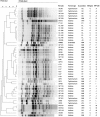CTX-M-27 Producing Salmonella enterica Serotypes Typhimurium and Indiana Are Prevalent among Food-Producing Animals in China
- PMID: 27065989
- PMCID: PMC4814913
- DOI: 10.3389/fmicb.2016.00436
CTX-M-27 Producing Salmonella enterica Serotypes Typhimurium and Indiana Are Prevalent among Food-Producing Animals in China
Abstract
Salmonella spp. is one of the most important food-borne pathogens causing digestive tract and invasive infections in both humans and animals. Extended-spectrum β-lactamases (ESBLs) especially the CTX-M-type ESBLs are increasingly being reported worldwide and in China. These studies seldom focused on Salmonella isolates from food-producing animals. The aim of this study was to characterize the antimicrobial resistance profiles, serotypes and ESBLs and in particular, CTX-M producing Salmonella isolates from chickens and pigs in China. Salmonella isolates were identified by API20E system and polymerase chain reaction (PCR) assay; serotypes were determined using slide agglutination with hyperimmune sera; antimicrobial susceptibility was tested using the ager dilution method; the prevalence of ESBLs and PMQR genes were screened by PCR; CTX-M-producing isolates were further characterized by conjugation along with genetic relatedness and plasmid replicon type. In total, 159 Salmonella strains were identified, among which 95 strains were Salmonella enterica serovar Typhimurium, 63 strains were S. enterica serovar Indiana, and 1 strain was S. enterica serovar Enteritidis. All of these isolates presented multi-drug resistant phenotypes. Forty-five isolates carried bla CTX-M genes, the most common subtype was CTX-M-27(34), followed by CTX-M-65(7) and CTX-M-14(4). Most bla CTX-M genes were transmitted by non-typeable or IncN/IncFIB/IncP/IncA/C/IncHI2 plasmids with sizes ranging from 80 to 280 kb. In particular, all the 14 non-typeable plasmids were carrying bla CTX-M-27 gene and had a similar size. PFGE profiles indicated that CTX-M-positive isolates were clonally related among the same serotype, whilst the isolates of different serotypes were genetically divergent. This suggested that both clonal spread of resistant strains and horizontal transmission of the resistance plasmids contributed to the dissemination of bla CTX-M-9G-positive Salmonella isolates. The presence and spread of CTX-M, especially the CTX-M-27 in S. enterica serovars Typhimurium and Indiana from food-producing animals poses a potential threat for public health. Control strategies to limit the dissemination of these strains through the food chain are necessary.
Keywords: CTX-M; Salmonella; antimicrobial resistance; food-producing animals; serotype.
Figures
References
-
- Alcaine S. D., Soyer Y., Warnick L. D., Su W. L., Sukhnanand S., Richards J., et al. (2006). Multilocus sequence typing supports the hypothesis that cow- and human-associated Salmonella isolates represent distinct and overlapping populations. Appl. Environ. Microbiol. 72 7575–7585. 10.1128/AEM.01174-06 - DOI - PMC - PubMed
-
- Bouallegue-Godet O., Ben S. Y., Fabre L., Demartin M., Grimont P. A., Mzoughi R., et al. (2005). Nosocomial outbreak caused by Salmonella enterica serotype Livingstone producing CTX-M-27 extended-spectrum beta-lactamase in a neonatal unit in Sousse, Tunisia. J. Clin. Microbiol. 43 1037–1044. 10.1128/JCM.43.3.1037-1044.2005 - DOI - PMC - PubMed
LinkOut - more resources
Full Text Sources
Other Literature Sources
Miscellaneous


